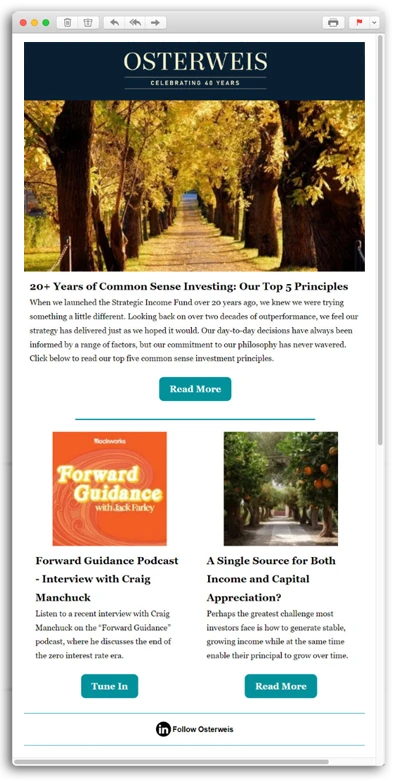Flexible Balanced
Minimum Investment
$5 million
More Information
Call us at (415) 434-4441 or email at contact@osterweis.com.
Overview
Our flexible balanced strategy combines our equity and fixed income strategies using a flexible allocation approach. The strategy seeks to capitalize on the growth attributes of equities and the capital preservation attributes of bonds.
Account Details
In our separately managed flexible balanced accounts, clients own a portfolio of both equity and fixed income securities. We strategically adjust the allocation of the portfolios based on our assessment of the attractiveness of individual investment opportunities and our macroeconomic and market views. For these accounts we are able to customize each portfolio based on individual needs such as legacy positions, cash flow or income needs, etc. that may not be met by a mutual fund.
Performance
Flexible Balanced Composite (as of 12/31/24)
| QTD | YTD | 1 YR | 3 YR | 5 YR | 7 YR | 10 YR | INCEP (10/1/2010) |
||
|---|---|---|---|---|---|---|---|---|---|
| Flexible Balanced Composite (gross) | 0.15% | 12.90% | 12.90% | 3.59% | 8.61% | 8.36% | 7.75% | 9.36% | |
| Flexible Balanced Composite (net) | -0.05 | 12.00 | 12.00 | 2.80 | 7.78 | 7.49 | 6.87 | 8.43 | |
| 60% S&P 500 Index/40% Bloomberg U.S. Aggregate Bond Index | 0.21 | 15.04 | 15.04 | 4.46 | 8.67 | 8.83 | 8.52 | 9.48 | |
Philosophy
We believe a portfolio of quality growth stocks combined with strategically selected bonds can deliver attractive levels of income and growth over time with less volatility.
For equities, we seek to purchase shares in quality growth companies when their growth opportunities are under-appreciated and not properly discounted in their current market value. We identify quality growth companies based on the durability of their competitive advantages, the opportunity for reinvestment to drive future growth, and management’s overall proficiency. Ultimately, we seek companies that can sustainably grow free cash flow per share while earning attractive and/or improving returns on capital.
On the fixed income side, we carefully select investments across high yield, convertibles, and investment grade. The investment team applies an equity-like security selection approach focused on attractively valued, misunderstood/out of favor bonds. We believe that by avoiding the “style box” trap and having the flexibility to invest in multiple classes of bonds, we can emphasize the most attractive sector at any given time. By strategically shifting out of overvalued assets, we strive to minimize potential risk and produce better returns over time.
Past performance does not guarantee future results.
Rates of return for periods greater than one year are annualized. The information given for these composites is historic and should not be taken as an indication of future performance. Performance returns are presented both before and after the deduction of advisory fees. Account returns are calculated using a time-weighted return method. Account returns reflect the reinvestment of dividends and other income and the deduction of brokerage fees and other commissions, if any, but do not reflect the deduction of certain other expenses such as custodial fees. Monthly composite returns are calculated by weighting account returns by beginning market value. Net returns reflect the deduction of actual advisory fees. Net return calculation:
- Prior to 1/1/2020, the composite net return is calculated using actual advisory fees with the following exception: one member of the composite was a mutual fund portfolio whose fee was partially waived at some point due to an expense limitation agreement. The composite net return shown during this period does not reflect this waiver and is therefore lower than the actual return.
- From 1/1/2020 onward, the composite net return is calculated using actual advisory fees.
- Our fees may vary between accounts due to portfolio size, client type, or other factors.
The 60/40 blend is composed of 60% Standard & Poor’s 500 Index (S&P 500) and 40% Bloomberg U.S. Aggregate Bond Index (Agg) and assumes monthly rebalancing. The S&P 500 is widely regarded as the standard for measuring large cap U.S. stock market performance. The Agg is widely regarded as a standard for measuring U.S. investment grade bond market performance. These indices do not incur expenses and are not available for investment. These indices include reinvestment of dividends and/or interest.
Source for any Bloomberg index is Bloomberg Index Services Limited. BLOOMBERG® is a trademark and service mark of Bloomberg Finance L.P. and its affiliates (collectively “Bloomberg”). Bloomberg owns all proprietary rights in the Bloomberg Indices. Bloomberg does not approve or endorse this material, or guarantees the accuracy or completeness of any information herein, or makes any warranty, express or implied, as to the results to be obtained therefrom and, to the maximum extent allowed by law, neither shall have any liability or responsibility for injury or damages arising in connection therewith.
The fee schedule is as follows: 1.25% on the first $10 million, 1.00% on the next $15 million up to $25 million, and 0.75% in excess of $25 million. A discounted, institutional rate is available.
Clients invested in flexible balanced separately managed accounts are subject to various risks including potential loss of principal, general market risk, small and medium-sized company risk, foreign securities and emerging markets risk, default risk, interest rate risk, inflation risk and liquidity risk. Additionally, there is a risk that we do not manage the asset allocation strategy successfully. For a complete discussion of the risks involved, please see our Form ADV Brochure and refer to Item 8.
The Flexible Balanced Composite includes all fee-paying separately managed accounts and mutual funds that are invested in a dynamic allocation of equity and fixed income securities as well as mutual funds and cash equivalents. OCM has discretion over individual investments as well as the discretion to increase and decrease equity exposure within the range of 25% to 75%. Individual account performance will vary from the composite performance due to differences in individual holdings, cash flows, etc.








